Shreya Agrawal
Beyond Next Word Prediction: Developing Comprehensive Evaluation Frameworks for measuring LLM performance on real world applications
Mar 05, 2025Abstract:While Large Language Models (LLMs) are fundamentally next-token prediction systems, their practical applications extend far beyond this basic function. From natural language processing and text generation to conversational assistants and software use, LLMs have numerous use-cases, and have already acquired a significant degree of enterprise adoption. To evaluate such models, static evaluation datasets, consisting of a set of prompts and their corresponding ground truths, are often used to benchmark the efficacy of the model for a particular task. In this paper, we provide the basis for a more comprehensive evaluation framework, based upon a traditional game and tool-based architecture that enables a more overarching measurement of a model's capabilities. For simplicity, we provide a generalized foundation that can be extended, without significant alteration, to numerous scenarios, from specific use cases such as supply chain management or financial reasoning, to abstract measurements such as ethics or safety.
WeatherBench 2: A benchmark for the next generation of data-driven global weather models
Aug 29, 2023Abstract:WeatherBench 2 is an update to the global, medium-range (1-14 day) weather forecasting benchmark proposed by Rasp et al. (2020), designed with the aim to accelerate progress in data-driven weather modeling. WeatherBench 2 consists of an open-source evaluation framework, publicly available training, ground truth and baseline data as well as a continuously updated website with the latest metrics and state-of-the-art models: https://sites.research.google/weatherbench. This paper describes the design principles of the evaluation framework and presents results for current state-of-the-art physical and data-driven weather models. The metrics are based on established practices for evaluating weather forecasts at leading operational weather centers. We define a set of headline scores to provide an overview of model performance. In addition, we also discuss caveats in the current evaluation setup and challenges for the future of data-driven weather forecasting.
Deep Learning for Day Forecasts from Sparse Observations
Jun 12, 2023Abstract:Deep neural networks offer an alternative paradigm for modeling weather conditions. The ability of neural models to make a prediction in less than a second once the data is available and to do so with very high temporal and spatial resolution, and the ability to learn directly from atmospheric observations, are just some of these models' unique advantages. Neural models trained using atmospheric observations, the highest fidelity and lowest latency data, have to date achieved good performance only up to twelve hours of lead time when compared with state-of-the-art probabilistic Numerical Weather Prediction models and only for the sole variable of precipitation. In this paper, we present MetNet-3 that extends significantly both the lead time range and the variables that an observation based neural model can predict well. MetNet-3 learns from both dense and sparse data sensors and makes predictions up to 24 hours ahead for precipitation, wind, temperature and dew point. MetNet-3 introduces a key densification technique that implicitly captures data assimilation and produces spatially dense forecasts in spite of the network training on extremely sparse targets. MetNet-3 has a high temporal and spatial resolution of, respectively, up to 2 minutes and 1 km as well as a low operational latency. We find that MetNet-3 is able to outperform the best single- and multi-member NWPs such as HRRR and ENS over the CONUS region for up to 24 hours ahead setting a new performance milestone for observation based neural models. MetNet-3 is operational and its forecasts are served in Google Search in conjunction with other models.
A Machine Learning Outlook: Post-processing of Global Medium-range Forecasts
Mar 28, 2023



Abstract:Post-processing typically takes the outputs of a Numerical Weather Prediction (NWP) model and applies linear statistical techniques to produce improve localized forecasts, by including additional observations, or determining systematic errors at a finer scale. In this pilot study, we investigate the benefits and challenges of using non-linear neural network (NN) based methods to post-process multiple weather features -- temperature, moisture, wind, geopotential height, precipitable water -- at 30 vertical levels, globally and at lead times up to 7 days. We show that we can achieve accuracy improvements of up to 12% (RMSE) in a field such as temperature at 850hPa for a 7 day forecast. However, we recognize the need to strengthen foundational work on objectively measuring a sharp and correct forecast. We discuss the challenges of using standard metrics such as root mean squared error (RMSE) or anomaly correlation coefficient (ACC) as we move from linear statistical models to more complex non-linear machine learning approaches for post-processing global weather forecasts.
Global Extreme Heat Forecasting Using Neural Weather Models
May 23, 2022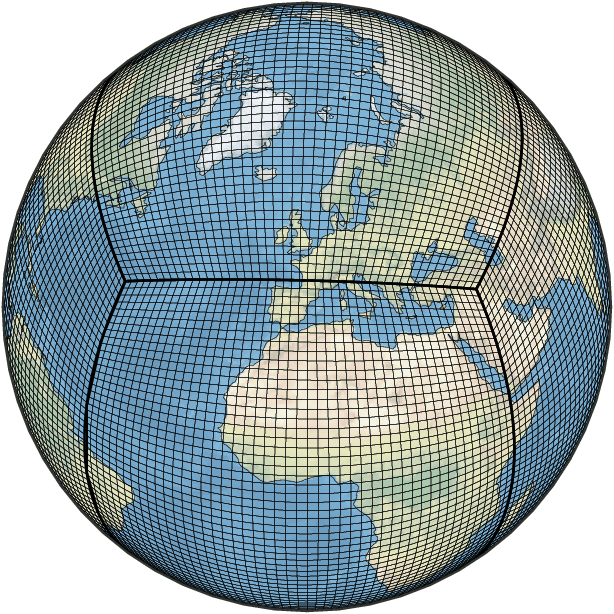
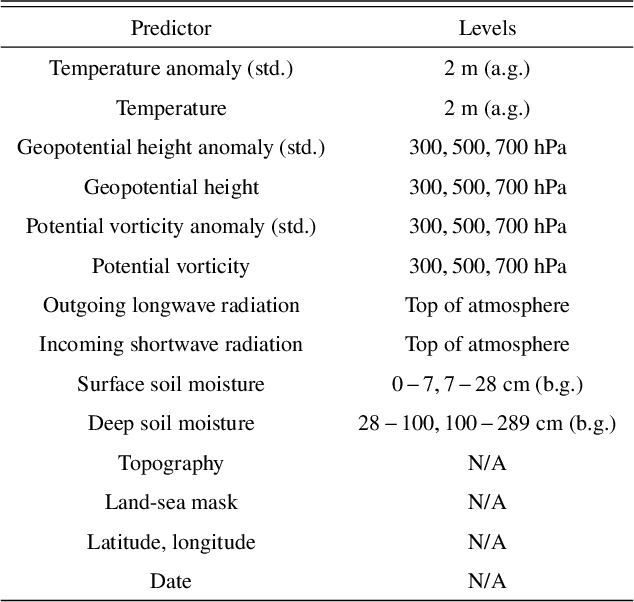
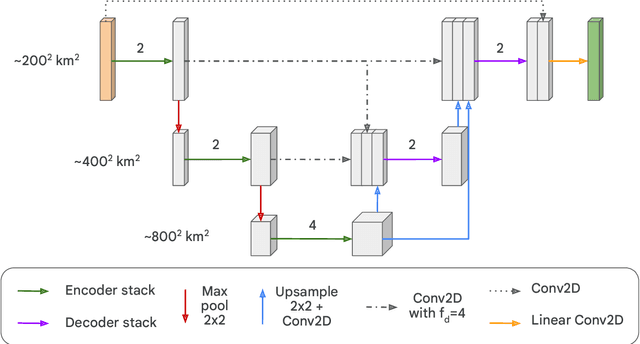
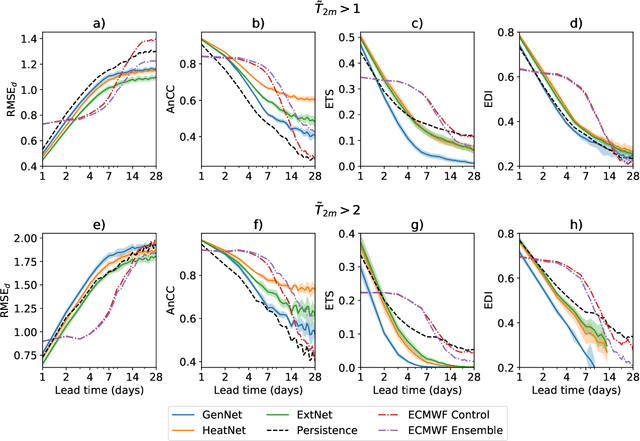
Abstract:Heat waves are projected to increase in frequency and severity with global warming. Improved warning systems would help reduce the associated loss of lives, wildfires, power disruptions, and reduction in crop yields. In this work, we explore the potential for deep learning systems trained on historical data to forecast extreme heat on short, medium and subseasonal timescales. To this purpose, we train a set of neural weather models (NWMs) with convolutional architectures to forecast surface temperature anomalies globally, 1 to 28 days ahead, at $\sim200~\mathrm{km}$ resolution and on the cubed sphere. The NWMs are trained using the ERA5 reanalysis product and a set of candidate loss functions, including the mean squared error and exponential losses targeting extremes. We find that training models to minimize custom losses tailored to emphasize extremes leads to significant skill improvements in the heat wave prediction task, compared to NWMs trained on the mean squared error loss. This improvement is accomplished with almost no skill reduction in the general temperature prediction task, and it can be efficiently realized through transfer learning, by re-training NWMs with the custom losses for a few epochs. In addition, we find that the use of a symmetric exponential loss reduces the smoothing of NWM forecasts with lead time. Our best NWM is able to outperform persistence in a regressive sense for all lead times and temperature anomaly thresholds considered, and shows positive regressive skill compared to the ECMWF subseasonal-to-seasonal control forecast within the first two forecast days and after two weeks.
Skillful Twelve Hour Precipitation Forecasts using Large Context Neural Networks
Nov 14, 2021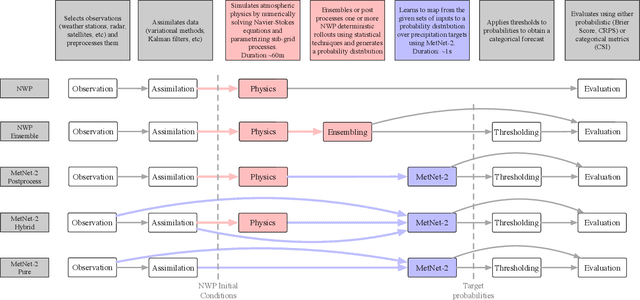



Abstract:The problem of forecasting weather has been scientifically studied for centuries due to its high impact on human lives, transportation, food production and energy management, among others. Current operational forecasting models are based on physics and use supercomputers to simulate the atmosphere to make forecasts hours and days in advance. Better physics-based forecasts require improvements in the models themselves, which can be a substantial scientific challenge, as well as improvements in the underlying resolution, which can be computationally prohibitive. An emerging class of weather models based on neural networks represents a paradigm shift in weather forecasting: the models learn the required transformations from data instead of relying on hand-coded physics and are computationally efficient. For neural models, however, each additional hour of lead time poses a substantial challenge as it requires capturing ever larger spatial contexts and increases the uncertainty of the prediction. In this work, we present a neural network that is capable of large-scale precipitation forecasting up to twelve hours ahead and, starting from the same atmospheric state, the model achieves greater skill than the state-of-the-art physics-based models HRRR and HREF that currently operate in the Continental United States. Interpretability analyses reinforce the observation that the model learns to emulate advanced physics principles. These results represent a substantial step towards establishing a new paradigm of efficient forecasting with neural networks.
MetNet: A Neural Weather Model for Precipitation Forecasting
Mar 30, 2020Abstract:Weather forecasting is a long standing scientific challenge with direct social and economic impact. The task is suitable for deep neural networks due to vast amounts of continuously collected data and a rich spatial and temporal structure that presents long range dependencies. We introduce MetNet, a neural network that forecasts precipitation up to 8 hours into the future at the high spatial resolution of 1 km$^2$ and at the temporal resolution of 2 minutes with a latency in the order of seconds. MetNet takes as input radar and satellite data and forecast lead time and produces a probabilistic precipitation map. The architecture uses axial self-attention to aggregate the global context from a large input patch corresponding to a million square kilometers. We evaluate the performance of MetNet at various precipitation thresholds and find that MetNet outperforms Numerical Weather Prediction at forecasts of up to 7 to 8 hours on the scale of the continental United States.
Machine Learning for Precipitation Nowcasting from Radar Images
Dec 11, 2019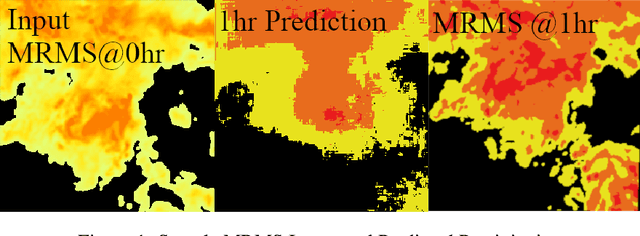

Abstract:High-resolution nowcasting is an essential tool needed for effective adaptation to climate change, particularly for extreme weather. As Deep Learning (DL) techniques have shown dramatic promise in many domains, including the geosciences, we present an application of DL to the problem of precipitation nowcasting, i.e., high-resolution (1 km x 1 km) short-term (1 hour) predictions of precipitation. We treat forecasting as an image-to-image translation problem and leverage the power of the ubiquitous UNET convolutional neural network. We find this performs favorably when compared to three commonly used models: optical flow, persistence and NOAA's numerical one-hour HRRR nowcasting prediction.
 Add to Chrome
Add to Chrome Add to Firefox
Add to Firefox Add to Edge
Add to Edge